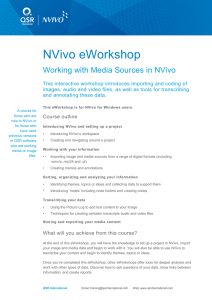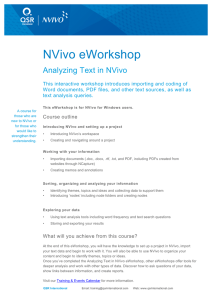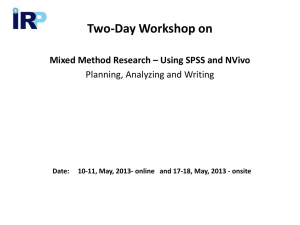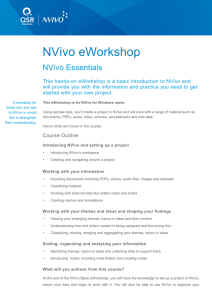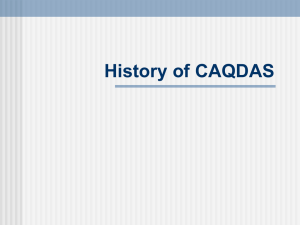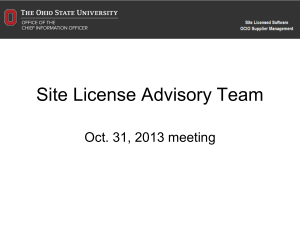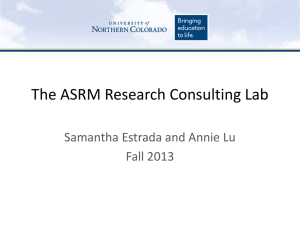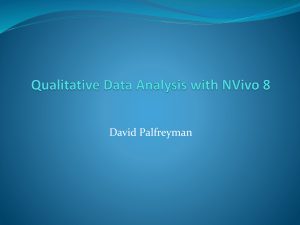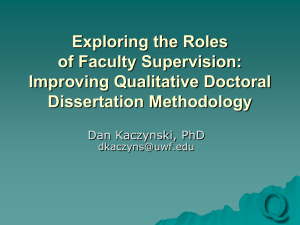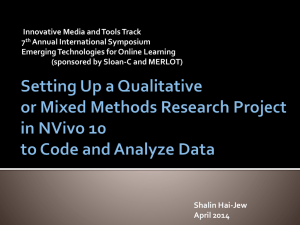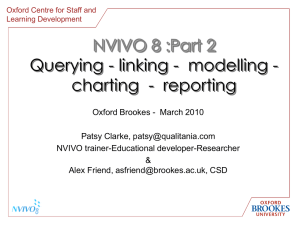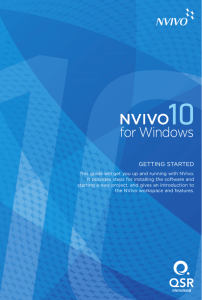Microsoft PowerPoint - the NCRM EPrints Repository
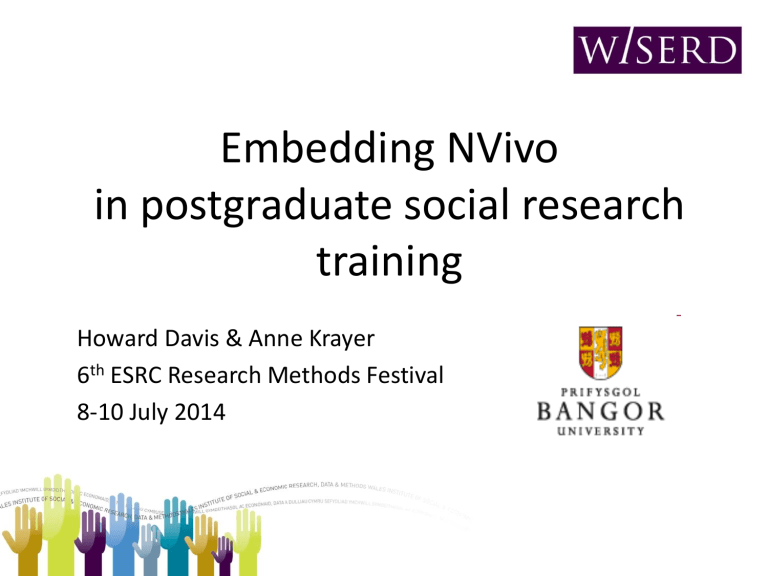
Embedding NVivo in postgraduate social research training
Howard Davis & Anne Krayer
6
th
ESRC Research Methods Festival
8-10 July 2014
SXU4002
The Research Process
• Postgraduate research training module for School of Social Sciences
• Originally designed for ESRC-recognized MA in Social Research & Social
Policy, incremental changes since then
• 40 credits over 2 semesters
• Approx 15-20 students including some +3 research
• Team delivery of teaching
Design
• Informed by the
ESRC Research Training Guidelines 2005 ->
• Specification for ‘generic training’
- principles of research design and strategy
- competence in a range of methods and tools
- capability to manage research, including ethics
- understanding alternative epistemologies
• Includes ‘practical experience’ and ‘proficiency in the analysis of qualitative data’. (Why Nvivo?)
Structure
Semester 1
Semester 2
Classroom-based
Epistemology, research questions, design and strategy
Using quant data, sampling, questions, survey design, descriptive statistics, significance testing
Reflexivity, feminist research
Collecting qualitative data
(observation, interviews), analysing and producing accounts, working with text and visual data
Lab-based Assessment
SPSS
NVivo
1
2
3
4
5
Dissertation preparation
Integration
A journey from:
Parallel sessions, minimal connection between software teaching and the research and design skills (‘bought in’ teaching) to
More coordination of topics: data collection – data preparation; category analysis – coding; writing issues – presentation of data
(‘in house’ teaching)
NVivo software
• Many options for document preparation (plain text, rich text with sections, audio clips, pictures, pdf and audio files, RefWorks data),
• Supports inductive or deductive, in vivo or researcher defined, manual or automated coding
• Many retrieval options for example by node [category], by document, text searches, matrix
• A wide range of search options including by attributes, folder, type of document, node
• Has dynamic links to memos, documents, and nodes
• Enables visual representations (e.g. coding stripes, models)
• The wide range of choices available means that the researcher must choose wisely amongst a set of tools and is by no means required to use them all!
Introduction to software
• Interactive teaching style (use of videos, examples, discussion and handson experience)
• Encouraged use of help function and trying out different ways to do achieve a task (e.g. coding)
• Challenges:
– Expectation that NVivo ‘codes for you’
– different levels of computer skills
– different levels of knowledge (and practical experience) of qualitative analysis approaches
Session content (4 weeks)
• Introduction to codes and coding
• Setting up a project in NVivo 9
• Importing documents and linking to external sources
• Developing and working with codes in NVivo
• Assigning attributes and working with classification sheets
• The use of memos
• Visual presentation of data
• Queries
• Use of NVivo videos: get up and running with NVivo, organise material into themes & Classifying nodes
First session
• Students’ substantive research interests & interest in using qualitative methods
• PowerPoint presentation on codes and coding including examples from the literature
• NVivo video (getting up and running with NVivo)
• Became clear that students:
– Only understand the process of coding in the abstract
– Started to worry about qualitative analysis
Following sessions
• Use of publically available transcripts (Attitudes to GM crops)
• Students engaged in coding, creating classification sheets, setting-up queries and visualising the data
• Challenges
– Students did not engage with the transcripts sufficiently to achieve meaningful coding
– Some students struggled with the software (which button to press) whereas others found this easy
– Sessions are not assessed
Linking methods teaching to NVivo
• Students need to be clear that their analysis is based on an appropriate methodological approach and a rationale for the methods of data collection and analysis
• Discussions in each sessions:
– about how NVivo might be used with the methods covered in the methods teaching sessions
– of what students learned and how they might apply this to their own research ideas and data
– Challenges using NVivo
– Using NVivo is not an ‘easy option’ and time is needed to read, conceptualise and analyse the data
Feedback from students
• Good introduction to the software
• Can now see a link between qualitative research and NVivo
• NVivo is not a magic wand!
• Need to have reasons to learn how to use NVivo
• Some students were planning to use
NVivo for their literature review to improve their skills with the programme and enhance their understanding of coding
Student suggestions for improvement
• More sessions to cover a wider range of skills
• Different levels (beginner, intermediate and advanced)
• Introduction of specific coding approaches (e.g. for content analysis, grounded theory or surveys)
• Have a range of tasks students have to achieve and they can work through at their own speed
• Use of peer support groups
Lessons learned
• Integration is difficult: In Semester 1 the same teacher delivers the quantitative topics and SPSS which allows very good integration.
Qualitative topics demand a wider range of experience and it takes longer to become familiar with discursive techniques.
• Pedagogic challenges: linking technical knowledge to methods teaching and critical thinking through experiential learning
• Mixed-methods approach: students tend to prefer qualitative methods as they are seen as an easier option
• Technical issues: wide range of prior computer skills
• Assessment? We have resisted separate assessment of computer skills
Further development
• Use the same material (e.g. a mixed-methods research project on attitudes to wind farms) in sessions on research methods as well as NVivo sessions to facilitate integrated learning
• Integrate some group exercises into NVivo teaching to facilitate peer learning
• Emphasise the importance of understanding how NVivo or similar programmes work – to be able to conduct your own project but also to understand how others have analysed their data

